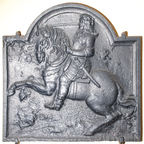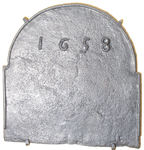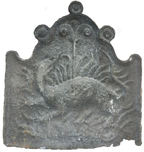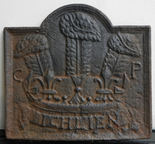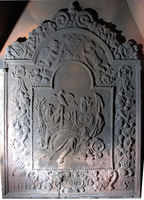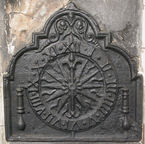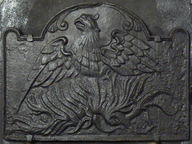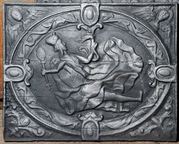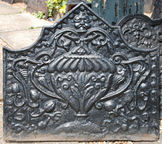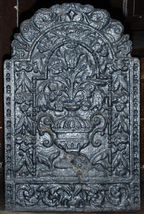-
523
Description: Arched rectangular shape; cavetto-moulded edging; figure in mid-17th century armour, sword in belt, riding a prancing horse; initials split, below corners of arch, in front of horse’s head and behind rider’s back.
Notes: Probably intended to represent Charles I in memoriam, as other firebacks in this style date from the end of the Commonwealth period. Mitford collection, Petworth House.
Copies of this fireback are known.
Inscription: [C missing] R
- Decoration tags:
- rectangular with round arch (shape)
- cavetto (edging)
- whole carved pattern
- pictorial
- text
- animals
- humans
Manufactured: in the mid-17th century in the Weald area of England.
Current location: Petworth House, Petworth, West Sussex, England.
Museum number: NT/PET/M/77 (part of the National Trust museum group)
Citation: Baines, J. M., 1958, Wealden Firebacks (Hastings Museum).
Citation: Lloyd, N., 1925, 'Domestic Ironwork I', Architectural Review, 58, pp. 58-67.
- Attached to series:
- Small cavetto series
-
532
Description: Arched rectangular shaped with narrow shoulders; fillet edging; date in individual numerals across arch.
Notes: A smaller version is different in the spacing of the numerals and the proportions of the plate. Mitford collection, Petworth House.
Inscription: 1658
- Decoration tags:
- rectangular with round arch (shape)
- rope (edging)
- carved stamps
- individual numbers
- text
Manufactured: in 1658 possibly in the Weald area of England.
Current location: Petworth House, Petworth, West Sussex, England.
Museum number: NT/PET/M/85 (part of the National Trust museum group)
- Attached to series:
- 1658 arched series
- Date only firebacks
-
891
Description: Quasi-arched rectangular shaped; unique, cavetto-moulded edging, which loops upon itself three times. A mythical salamander shown in the flames which legend states it is able to resist; behind is what appears to be a palm tree.
Notes: Other known variants are dated; this variant confirms that the dates were added to subsequent castings. Corrosion to the bottom right corner may have obliterated a letter 'M' seen on another casting; presumably part of 'IM'.
- Decoration tags:
- rectangular with ornate arch (shape)
- cavetto (edging)
- whole carved pattern
- pictorial
- mythological
- animals
Manufactured: in the mid-17th century possibly at Brede Furnace in the Weald area of England.
Current location: not known.
Citation: Schubert, H. R., 1957, 'A Forgery in Iron', Journal of the Iron & Steel Institute, 165, p. 125.
- Attached to series:
- Hooked '1' series
- Loop edged firebacks
- Brede group
-
198
Description: Arched rectangular shape; cavetto-moulded edging; English royal coronet with three ostrich feathers rising from within; below, a motto scroll with inscription.
Notes: The badge of the Prince of Wales; the initials, CP, are probably for Carolus Princep; the motto is mis-spelled in error for 'Ich Dien' - I serve, which is more likely a mistranscription rather than a deliberate slur. The apparent crack in the angle of the arch and the top left of the fireback is an impression, indicating that this is a recasting.
Copies of this fireback are known.
Inscription: C P/ICH LIEN
- Decoration tags:
- rectangular with round arch (shape)
- cavetto (edging)
- whole carved pattern
- heraldic
- royal
- text
Manufactured: in the mid-17th century possibly in the Weald area of England.
Current location: not known.
- Attached to series:
- Prince of Wales firebacks
-
586
Description: Arched rectangular shaped central panel with bead edging; pictorial scene of a seated female figure resting against a hurdle, holding an anchor, a child on each side of her, the one on the left standing clutching corn stalks, the one on the right sitting also holding the anchor and a circular object; a bird sits on a post; arched rectangular border with bead edging; fructal and floral festoons suspended on ribbons with two putti at the top and two on each side; in the left and right bottom corners, the initials 'HH' and 'S' respectively; at the bottom, a central cartouche with date, between floral swags; on top, twin spirals between descending floral festoons.
Notes: The figure is an allegory of Hope. The theft in 1699 from a Thames-side warehouse of several firebacks, including '3 of Hope with an Anchor' may refer to this type (Post Boy 11-14 Nov. 1699).
Copies of this fireback are known.
Inscription: HH 1665 S
- Decoration tags:
- 'Dutch' (shape)
- ovolo (edging)
- whole carved pattern
- pictorial
- allegorical
- text
- animals
- humans
- objects
Manufactured: in 1665 in the Siegerland area of Germany.
Current location: in private hands, Plaxtol, Kent, England.
- Attached to series:
- 'Dutch' HHS series
- Hope firebacks
-
589
Description: Double arched rectangular shaped; ovolo edging; central clock dial with Roman numerals separated by stops, sunburst inside, single hand with fleur de lys pointer; teardrop weights suspended from each side; symmetrical tendrils above.
Notes: One of the ‘hooked 1’ series of firebacks - the number ‘1’ is just discernable bottom left; two versions exist of this fireback, the other having finials above the suspended weights.
Copies of this fireback are known.
Inscription: I · II · III · IIII · V · VI · VII · VIII · IX · X · XI · XII / 16...
- Decoration tags:
- rectangular with round arch (shape)
- ovolo (edging)
- whole carved pattern
- text
- objects
Manufactured: in the mid-17th century possibly at Brede Furnace in the Weald area of England.
Current location: Ham House, Richmond, Surrey, England.
Museum number: 1139737 (part of the National Trust museum group)
- Attached to series:
- Hooked '1' series
- Brede group
-
590
Description: Quasi-arched rectangular shape, semi-circular protrusions on top corners; cavetto-moulded edging; two mirrored scrolls inside arch; a phoenix in flames, its wings displayed and inverted.
Notes: A defaced variant of no. 895, which bears the date, 1650, and the initials, IM; a loop normally at the top is absent, and careless pouring of the iron has obliterated some of the detail down the right side of the casting.
Copies of this fireback are known.
- Decoration tags:
- rectangular with round arch (shape)
- cavetto (edging)
- whole carved pattern
- planklines
- pictorial
- mythological
- animals
Manufactured: in the mid-17th century possibly at Brede Furnace in the Weald area of England.
Current location: Ham House, Richmond, Surrey, England.
Museum number: 1139821 (part of the National Trust museum group)
- Attached to series:
- IM series
- Hooked '1' series
- Brede group
- Phoenix firebacks
-
598
Description: Rectangular with fillet edging; central, oval panel with fillet edging containing the semi-reclining, begowned figure of Cleopatra, a mirror/sceptre in her right hand and an asp in her left hand; oval border with astragal and fillet edging and undulating foliage; in each of the top spandrels, a face of a putto; in the bottom spandrels, a triangular design of swirled foliage; at the centre of each side, overlapping the central oval border, an oval cartouche with scrolls in the inward facing side; four horizontal plank lines regularly spaced.
Notes: The naivety of the figuration and the similarity of the scrolled designs suggest that this may be the work of the same pattern-maker as the Lenard fireback. Three tapestries of the death of Cleopatra, one of them made for the Swedish royal court, were inspired by artwork by Karel van Mander II (1579-1623), which is likely to have been the inspiration for this fireback as well.
- Decoration tags:
- rectangular (shape)
- fillet (edging)
- whole carved pattern
- planklines
- pictorial
- historical
- humans
Manufactured: in the mid-17th century in the Weald area of England.
Current location: Mark Ripley Forge & Fireplaces, Northbridge Street, Robertsbridge, East Sussex, England.
- Attached to series:
- Brede group
-
638
Description: Rectangular with cavetto curves rising to corners and a ‘pediment’ top; fillet edging with low-relief, alternate regularly-spaced semi-circles and triangles inside; two-handled flower vase with gadrooned upper surface and symmetrical flower design in relief below; trailing vines and flowers issuing from top and descending through handles to base; human face at top; second half of date to right of vase base.
Notes: Another version, probably by a different pattern-maker, is dated 1662; a recasting; an earlier casting measures 665mm x 610mm
Copies of this fireback are known.
Inscription: [...] 52
- Decoration tags:
- rectangular with canted top corners and triangular arch (shape)
- scalloped fillet (edging)
- whole carved pattern
- pictorial
- text
- plants
- objects
Manufactured: in 1652 possibly at Brede Furnace in the Weald area of England.
Current location: Mark Ripley Forge & Fireplaces, Northbridge Street, Robertsbridge, East Sussex, England.
- Attached to series:
- Gadrooned vase firebacks
- Hooked '1' series
- Brede group
-
654
Description: Arched rectangular central panel with bead-and-pellet edging; S-scroll, two-handled, gadrooned vase with tulip stems, flowers and leaves; arched rectangular border with fillet edging and suspended flower bunches; along a rectangular bottom panel with fillet edging a symmetrical arrangement of swirled foliage; on top, two symmetrical, coiled serpents; narrow, curved shouldered side panels with beads in oval depressions.
Notes: The presence of tulips suggest a Dutch origin for the pattern of this fireback, although the presence of several examples in England suggest that it was produced here rather than on the Continent.
Copies of this fireback are known.
- Decoration tags:
- 'Dutch' (shape)
- fillet (edging)
- whole carved pattern
- extension panels
- pictorial
- plants
- objects
Manufactured: in the mid-17th century in England.
Current location: Eastgate House, High Street, Rochester, Kent, England.
Museum number: A3507 (part of the Rochester Guildhall Museum museum group)
- Attached to series:
- Flower Vase 'Dutch' types
- British 'Dutch' style firebacks
